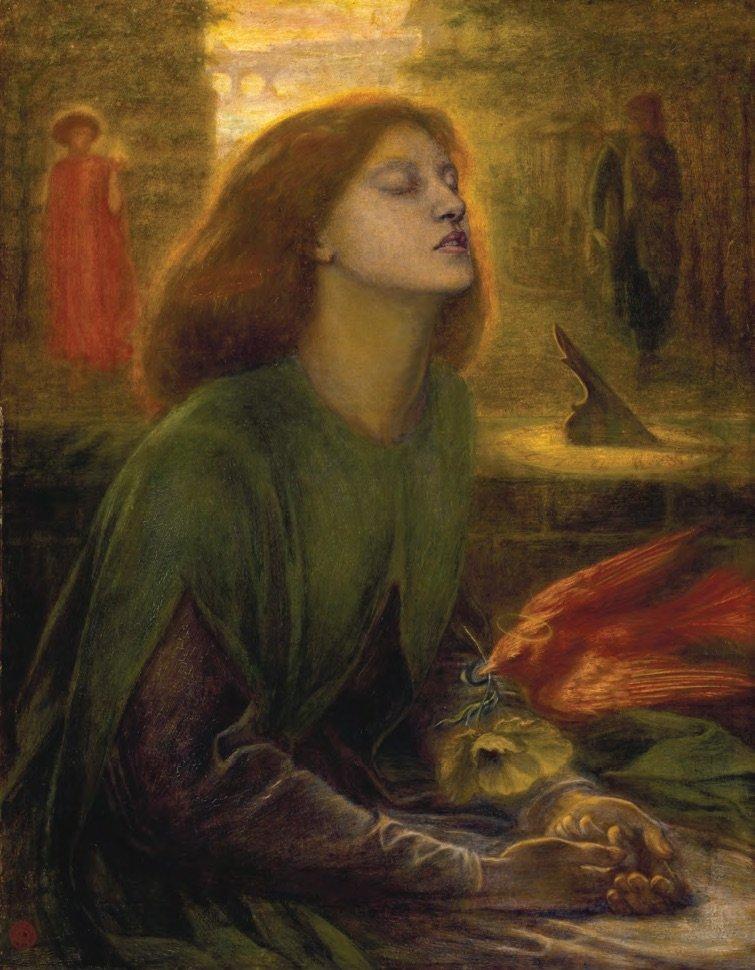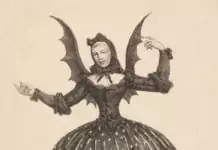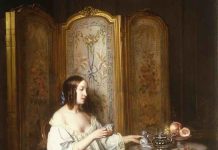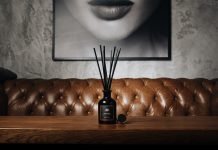“Down with the pretty ladies of the old school! Down with the old masters! Away with the pretty ladies!”
Ken Russell’s Dante’s Inferno (1967), a BBC biopic of Dante Gabriel Rossetti, features rebels building a bonfire of classical paintings, prancing among the flames with torches, shouting their dismissal of the elegant women who modeled for the masters. But the film opens with the exhumation of Rossetti’s own pretty lady, his dead wife and fellow artist, Lizzie Siddal, a hand reaching in among the skeleton’s wild locks of hair to retrieve the pages of Rossetti’s poetry he’d had buried with her in his time of mourning. (Seven years after Rossetti abandoned his poems thusly, he allowed his literary agent to secretly dig her up to pluck the manuscript from the pillow of Siddal’s coffin; to Rossetti’s disappointment, the pages were decayed and falling apart, worms having devoured some of his favorite lines from his poem “Jenny,” about a prostitute.)
While Dante’s Inferno was filmed in black and white, the history of the Pre-Raphaelites, and so much of Victorian-era artistry, seems to me steeped in color. It seems also steeped in death and romance (preoccupied, especially, with the romantic decline of women). Arsenic, lead, earth, ash, poison—all of it a palette for portraits of beauty by mortals summoning spirits with paint and pigment.
By some accounts, Siddal was addicted not only to laudanum (the drug that killed her) but to an arsenical face powder she used cosmetically. And arsenical paints were irresistible to not only Victorian artists but anyone seeking to commune with the extremities of color. One of the most comprehensive books on color from the era, Chromatography; Or, a Treatise on Colours and Pigments, by George Field, includes a warning with its recommendation of Arsenic Yellow: “It must not be forgotten that it is poisonous.”
Arsenic as a Domestic Poison, by Edward S. Wood, M.D. (1885) explores the medical statutes of various countries in its approach to arsenical paints. In Russia: “The employment of substances injurious to health for coloring articles of food and sweetmeats, such as comfits and gingerbread, marmalade, pastille ices, etc., shall be entirely prohibited.” However, it does allow for some industrial uses of arsenic paint, when beautification is of high necessity: “exception to these rules shall only be made in favor of wall-paper, and for tissues in which the patterns, flowers, leaves, moths, stripes, etc., are alone traced in arsenical paint on a more extensive ground of non-arsenical coloring matter.”
A prolific author of parenting guides, Pye Henry Chavasse, makes sure to repeat his warnings about arsenical paint in many of his books, including Wife and Mother; or, Information for Every Woman, and Advice to a Wife on the Management of Her Own Health and on the Treatment of Some of the Complaints Incidental to Pregnancy, Labour, and Suckling. In his The Physical Training of Children (1875), he writes of the dangers of these sucklings sucking paint: “Children’s paint-boxes are very dangerous toys for a child to play with: many of the paints are poisonous, containing arsenic, lead, gamboge, etc., and a child, when painting, is apt to put the brush into his mouth, to absorb the superabundant fluid. Of all the colors, the green paint is the most dangerous, as it is frequently composed of arsenite of copper—arsenic and copper—two deadly poisons.” He concludes the section with this helpful advice: “There are some paint-boxes warranted not to contain a particle of poison of any kind: these ought, for a child, to be chosen by a mother.”
The lead in paint even led to a common diagnosis, something called “painter’s colic,” a deathly condition affecting artists, trapped in their musty garrets, breathing in the toxic fumes of their paints. Pre-Raphaelite hanger-on James McNeill Whistler is said to have suffered from painter’s colic for a time, which certainly didn’t subdue his Harmony in Blue and Gold, otherwise known as the “Peacock Room,” an extravagant, richly imagined interior design and mural project.
The writer Lord Ronald Gower (who is believed to be Oscar Wilde’s inspiration for the character Lord Henry Wotton in The Picture of Dorian Gray) wrote about the Peacock Room for Vanity Fair, under the pen name Talon Rouge, while Whistler was still at work on the project in 1877: “I pity those who may have to look forward to a long succession of meals in this room of harmony. One could not feed on ordinary food in such a room. Perhaps locusts and wild honey might be allowed, but then comes the question of the apparel to be worn on these solemn occasions. I know only of one ladies’ costume which would not interfere with the gold and blue around and above, and that dress (including a hat) is composed entirely of peacock feathers, but I fear it has moulted long ago.”
But color in the 19th century wasn’t always fatalistic and melodramatic; it was often quite quiet, and even poetical. Artists’ manuals of the day describe paints and pigments derived from such things as “the inspissated juice of buckthorn berries,” from volcano ash dug up from the earth, from cuttlefish, horse hestnuts, the juice of the leek, from rue, parsley, columbine, and black nightshade, from the bones of pigs, stags, and oxen, and the stones of peaches.
“A pigment known as ‘purree’ or Indian yellow is produced in Monghyr from the urine of horned cattle fed on decayed and yellow mango leaves,” according to Animal Products: Their Preparation, Commercial Uses, and Value (1877).
A writer credited as Mrs. Merrifield, author of Original Treatises Dating from the XIIth to XVIIth Centuries, on the Arts of Painting (1849), describes the pigment kermes as derived from “the dead bodies of the female insect of the coccus ilicis, which lives upon the leaves of the prickly oak.”
Mrs. Merrifield seems to perfectly capture the Pre-Raphaelite inspiration to marry art and environment in this cityscape: “The colour called Venetian red is procured from Verona. Besides its use in painting, this earth was formerly much employed in making the bricks of which many of the old buildings of Venice are constructed. The fine colour of these bricks, heightened perhaps by their contrast with the green waters of the narrow canals, can scarcely have escaped the observation of travellers.”





































